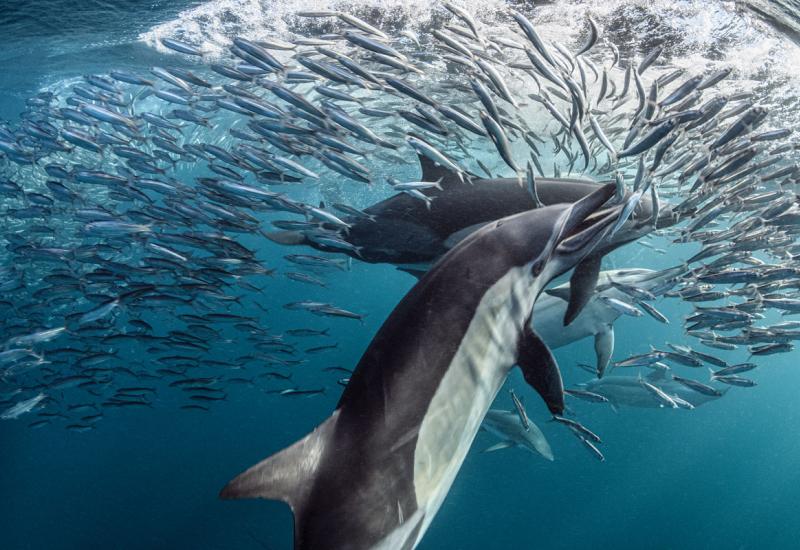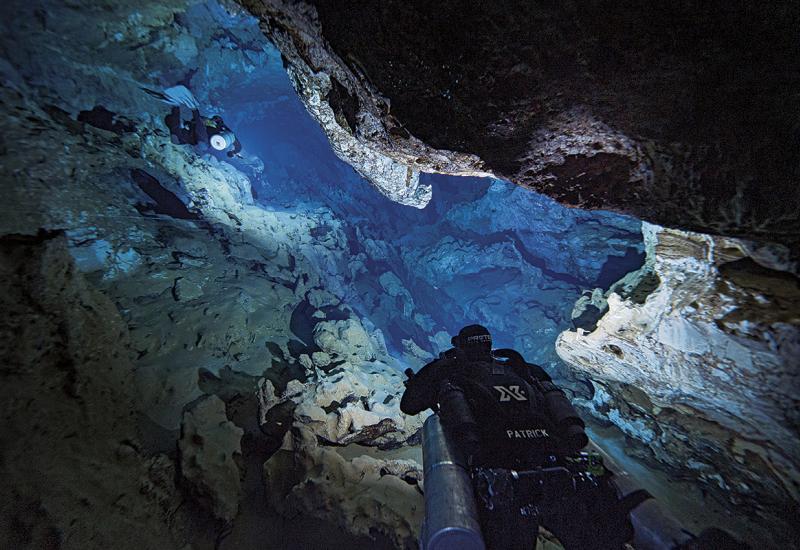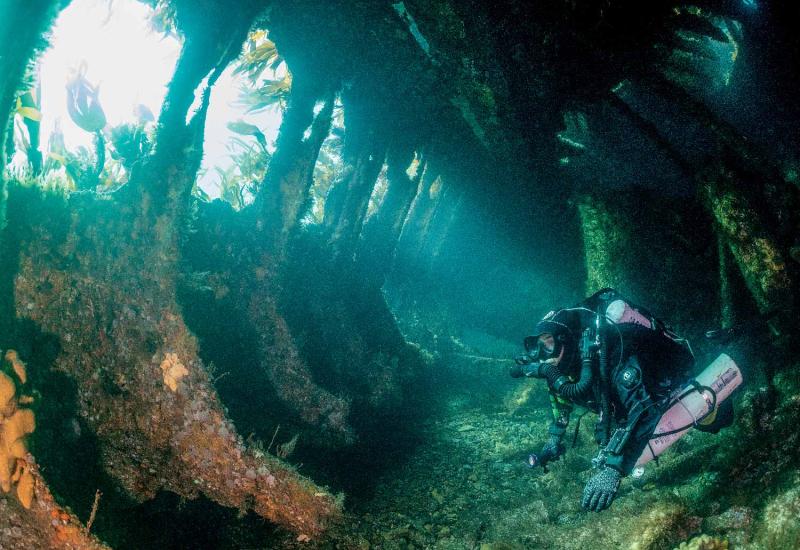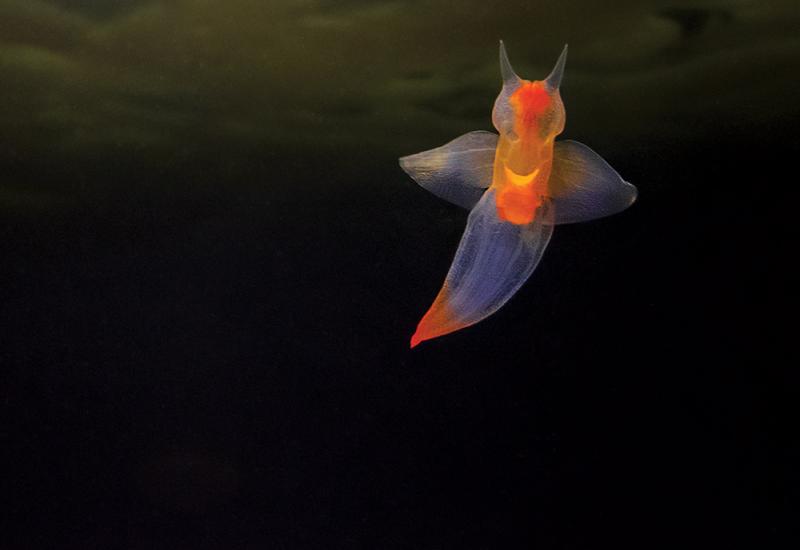What It's Like to Cave Dive in Budapest
Where can divers explore a spectacular cave system in tropically warm waters, right underneath one of the great cities of Europe? Budapest, where historic thermal baths derive their heat from natural springs deep in the Molnár János cave.
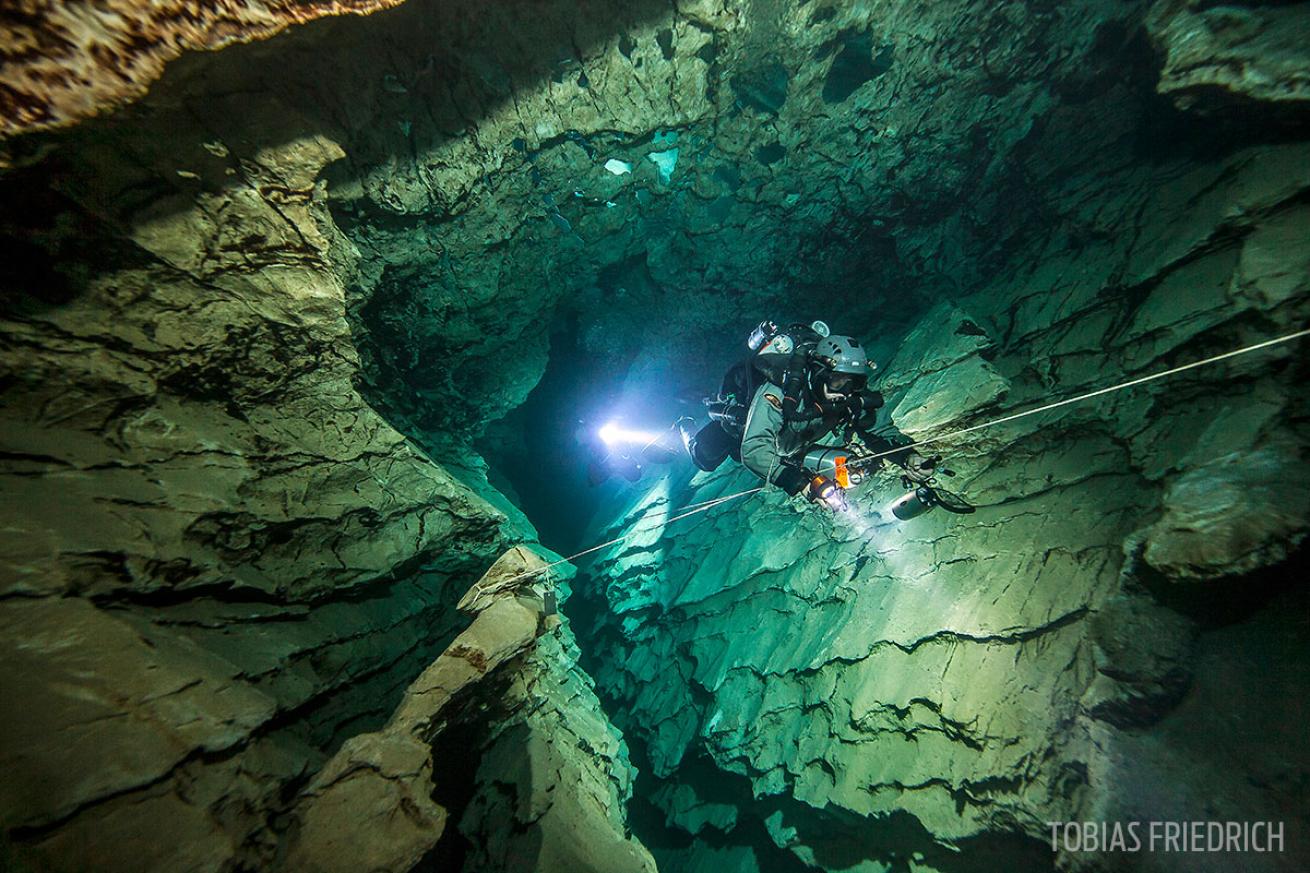
Tobias FriedrichIn the belly of the buda.
You can smell the subtropical heat and humidity.
Everyone who enters Molnár János notices it immediately — with each step into the cave, the sensation increases. Once sweat starts running down their back, visitors wish they had brought a swimsuit and flip-flops.
The source of this extreme heat in the middle of Budapest — Hungary’s capital, which sits at about the same latitude as Minot, North Dakota — is the hot thermal springs that warm the waters at the highest level of the flooded cave to 82° Fahrenheit.
The entrance, in the vicinity of the Lukáz thermal bath, gives no clue to the wonders within. No sign, no advertising — just an old gate and a small gravel parking lot, behind which is one of the most incredible dive sites in Europe. Around an old storefront, a wooden palisade leads to a shaft into the cave, its entrance about 325 feet inside one of Buda’s mountains. (Pest, on the eastern side of the Danube River, is flat.) Double tanks and rebreathers are stacked on long metal tables. Dozens of stage tank bottles are ready to go, along with hundreds of drysuits.
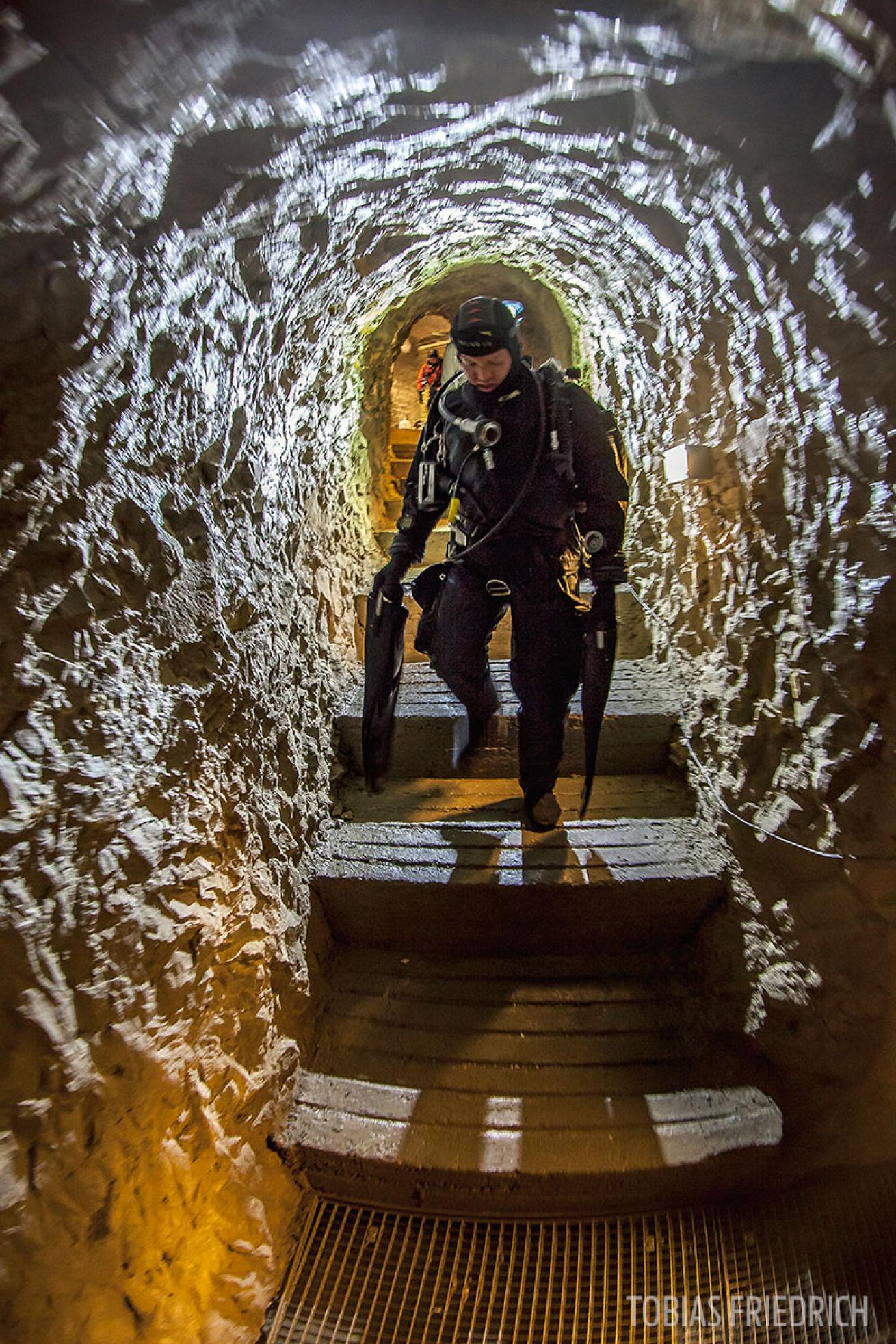
Tobias FriedrichDescending tunneled steps to the entry platform.
A pair of dark brown eyes critically considers every newcomer. They belong to Attila Hosszú, who holds the sole government license to regulate dive operations in the cave. He alone sets the rules, and for good reason: A diver died here some years ago of unexplained causes, and the government promptly prohibited diving, which had taken place in a gray area of little regulation. Today, to ensure that accident remains an anomaly, Hosszú pays close attention to the following requirements: Divers must have at least an intro-to-cave-diving certification or they cannot dive in the tunnels; they must have dive insurance that covers cave diving; and they must have air supplied in the form of double tanks, stages or a rebreather. In addition, each dive is accompanied by a guide, to minimize the risk of a wrong turn.
“It is very important to follow all the rules, to be able to return home safely,” Hosszú admonishes us with deadly seriousness.
“Attila is actually a very funny guy. On some days, he even laughs,” says Zoltan Bauer, one of the guides at Molnár János, elbowing Hosszú in the side. The gesture elicits a slight grin that makes clear Hosszú is really an easygoing type, but only after the day’s dives are safely completed. Inside the cave system, passageways go more than 300 feet deep in many directions. Some corridors come together again; others end after hundreds of yards in dead ends. Woe to those who don’t know the cave well enough or have not planned their dive exactly. Hosszú and his assistants have set up more than half a mile of cave lines, but much is still undiscovered beyond. “For the moment, we have reached our limit of four to five hours, even with the rebreathers, unfortunately,” Hosszú explains. The rest of the cave needs even more elaborate planning in order to explore fully. In the past several months, Hosszú and other experienced cave divers have renewed miles of lines that were previously rudimentary.
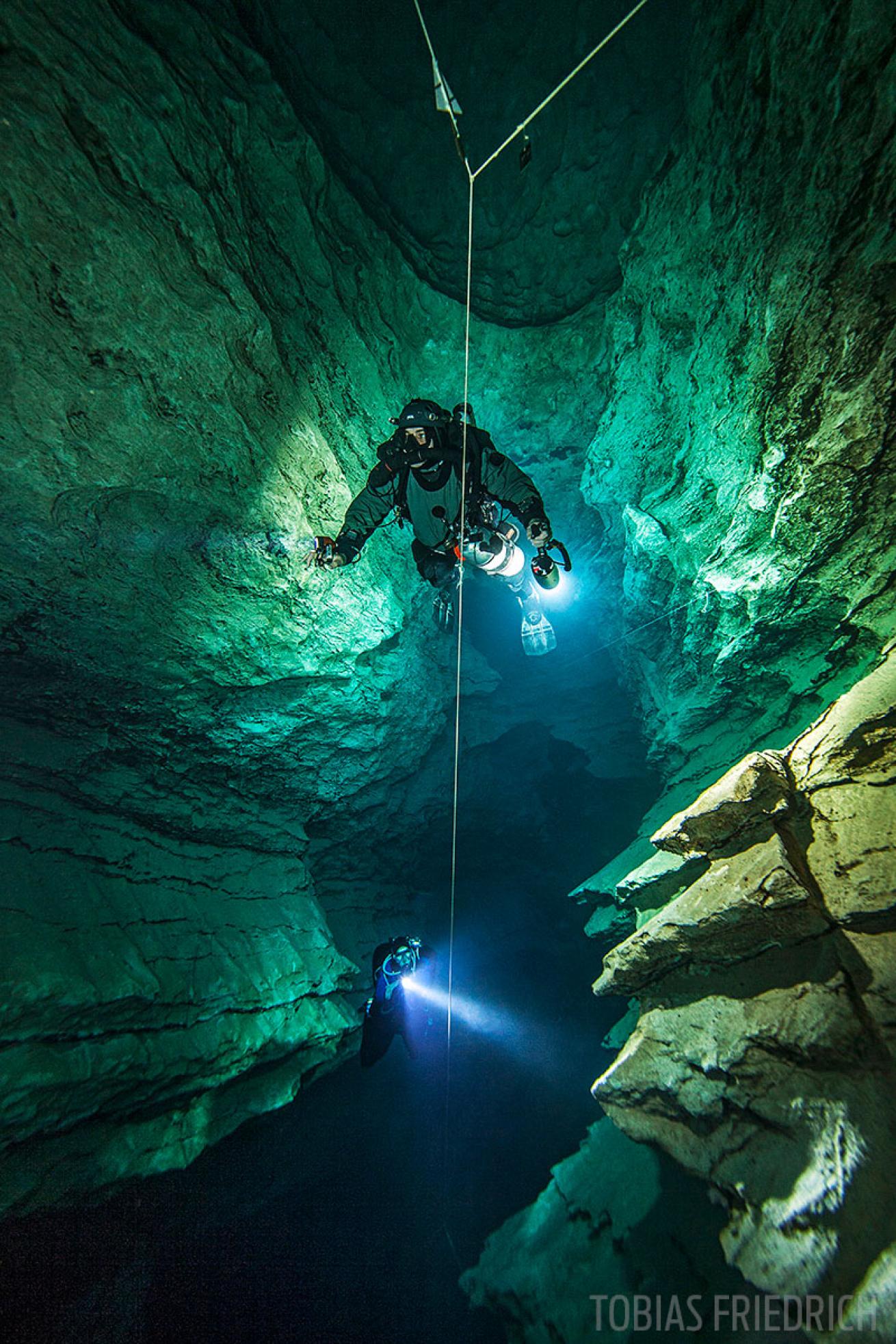
Tobias FriedrichA rebreather diver in Molnár János.
“Some ropes were actually just twine,” he says. “Now, in the most important parts of the cave, there are decent lines with professionally directed arrows, which always point to the nearest exit.”
Improvements extend far beyond laying new lines. The old entrance, through a narrow, outlying shaft, is used only in an emergency or for certain diving profiles. Now a long run leads directly to the base of the site, where divers prepare to submerge. On a large whiteboard used for dive briefings is the cave plan. The biggest improvement, however, was a 100-foot-long breakthrough from the main course down to a large pool that is an ideal starting point for the dives. Everything is designed with purpose: A large platform and a massive ladder serve as an entrance, and walls are secured with large steel nets, so no sudden rockfall can injure a visitor.
Everything is thought of, including the support of divers who want to go deeper than 130 feet or to use various breathing gases — the scrubber lime Sonfolime can be pre ordered, trimix gas mixtures are refueled, and much equipment, such as double tanks and stages, can be rented.
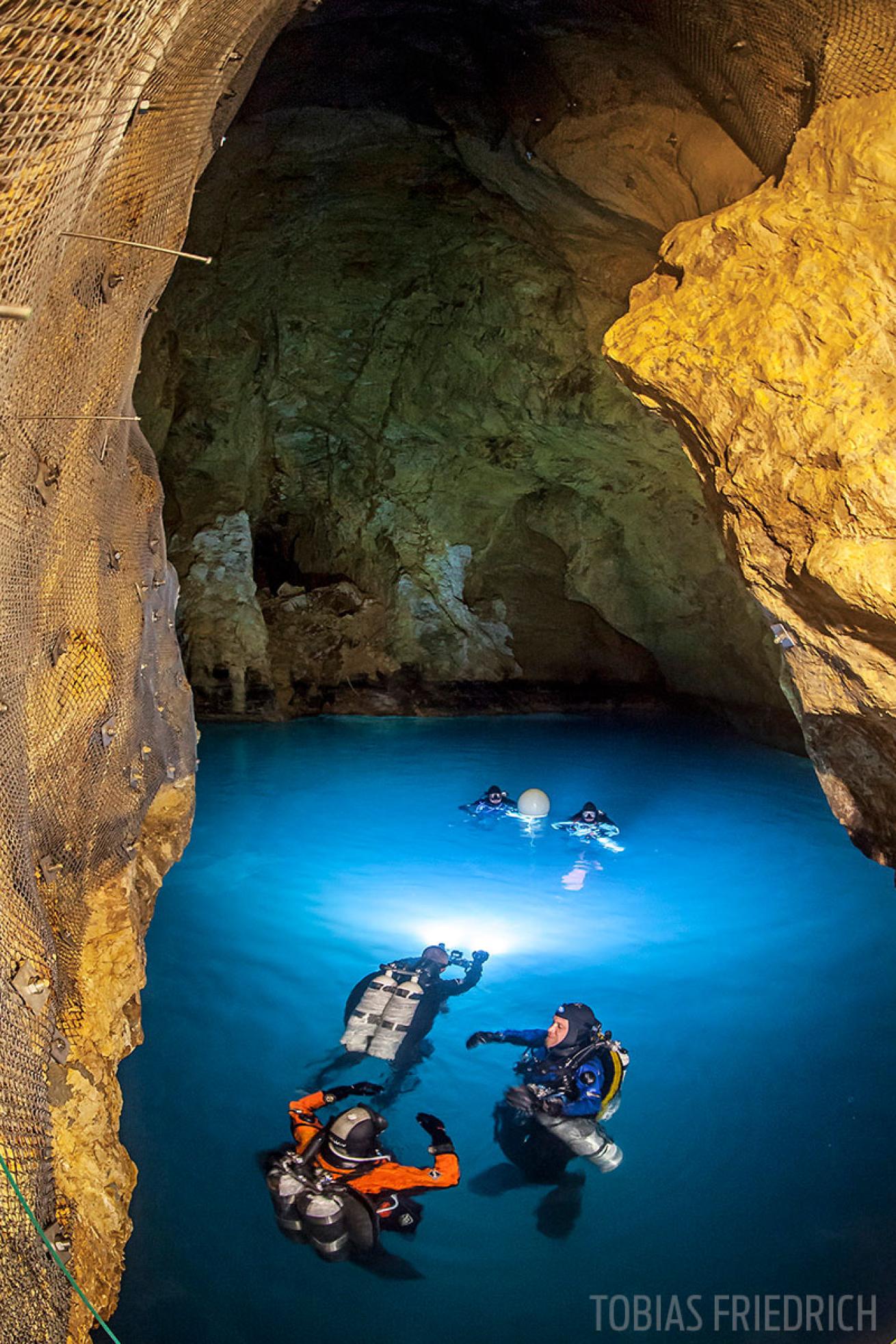
Tobias FriedrichDivers' lights illuminate the water-filled cave system, located in the Rozsadomb district of Budapest.
A massive sliding door separates the main passage from a breakthrough tunnel to the cave, a gateway to another world. In the light of torches, the high rocks of the entrance seem like a synagogue of light and shade, while underneath divers lies the pitch-black depth of Molnár János.
Dark World
On the descent, eyes are desperate for references, visible only after a few dark yards: Fine sediment covers the cave walls and reveals buoyancy mistakes immediately. This is why extreme caution is advised — otherwise, divers run the risk of zero visibility really quick. It’s important to follow the guide and stay together; after a few minutes, no direct ascent is possible. At about 30 feet, a thermocline layer of water in the mid- to high 60s makes a long penetration impossible without a drysuit. For certain passages, a drysuit is required, mainly because of the additional buoyancy device. Expelled air bubbles of divers on open circuit dislodge a fine sediment dust from the ceiling, a clear advantage for rebreather divers who have perfected their buoyancy control.
The world in the cave is a dark one: Unique formations created over thousands of years can be seen only where torches throw their light. Around every corner, it looks the same — and yet not: There are fine differences in the sediment, and completely different structures. Steeple-high cathedrals of stone and rock, whose true height can only be guessed at in the flash of an underwater camera, reveal our depth.
Deep columns indicate the history and origin of this cave: Budapest lies on a tectonic-plate gap, which created the long underground passages where water is heated by proximity to Earth’s core.
“We have been able to pinpoint four thermal springs in Molnár János,” Hosszú says. “Even if divers swirl a lot of sediment in a section, it is gone relatively quickly as the springs create a slight current that ensures a regular exchange.”
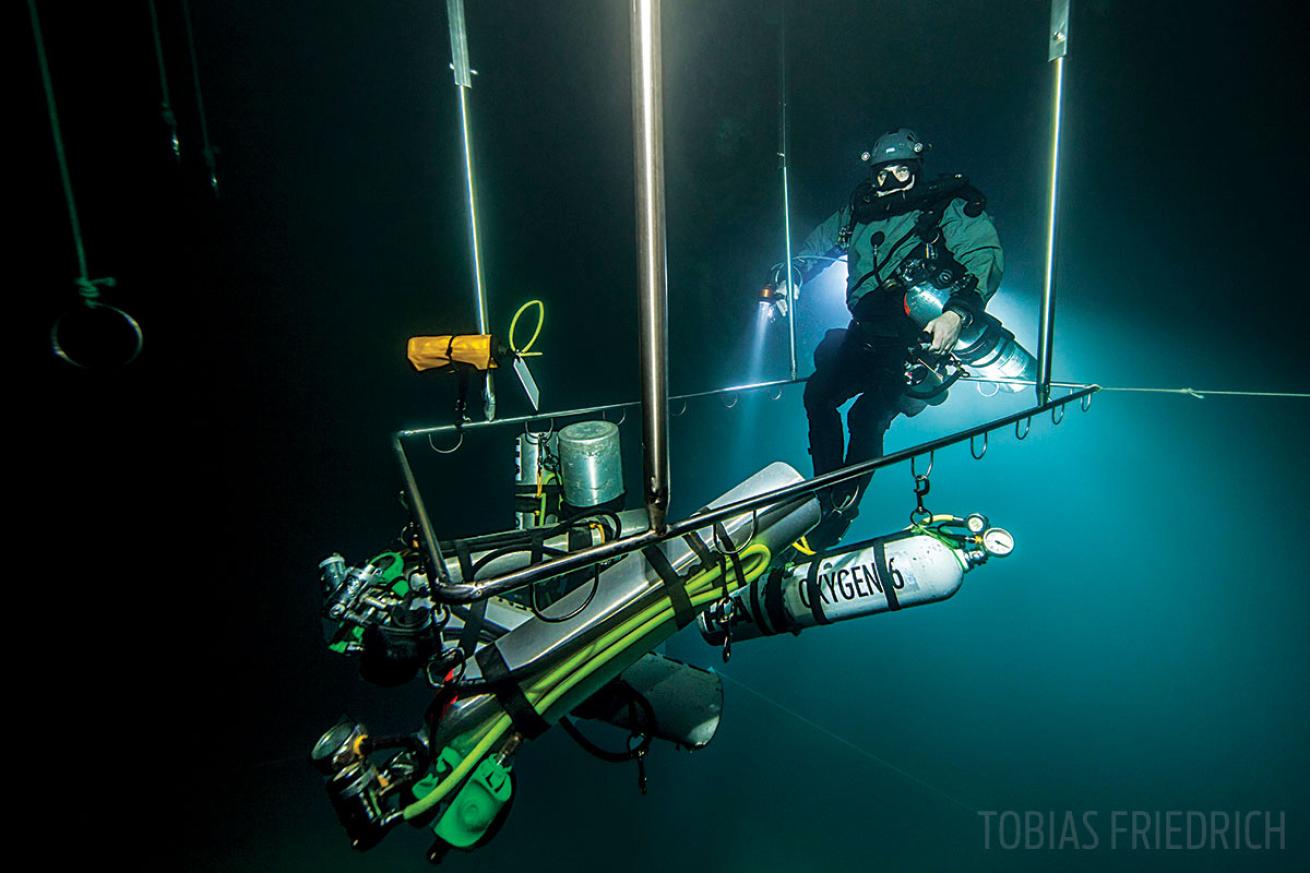
Tobias FriedrichResting on a rig suspended for staging tanks.
Back on the surface, we ask Hosszú if he has a favorite place in the cave. “Everywhere” is the terse answer. After repeated hemming and hawing, he tells the truth: He doesn’t want to reveal his favorite site because he’s afraid that would lead to too many divers there. It’s not the answer we wanted, but perhaps it’s the right one: Divers should discover the magic of Molnár János for themselves.
Hungry, we put aside the discussion in favor of choosing a restaurant: Just steps away from the cave entrance is the modest-looking but outstanding Földes Józsi vendéglője. Hungarian goulash soup, roasted pike perch or crispy duck: Almost all dishes are incredibly delicious and, far from the tourist crowds, extremely cheap. It’s a perfect ending, to talk about the experiences that have just taken place a few yards below our feet. Even Hosszú is transformed — no longer the professional cave diver who knows Molnár János as well as his vest pocket, he becomes a man with a hearty laugh, sharing anecdotes with visitors who now are comrades in Molnár János as well.
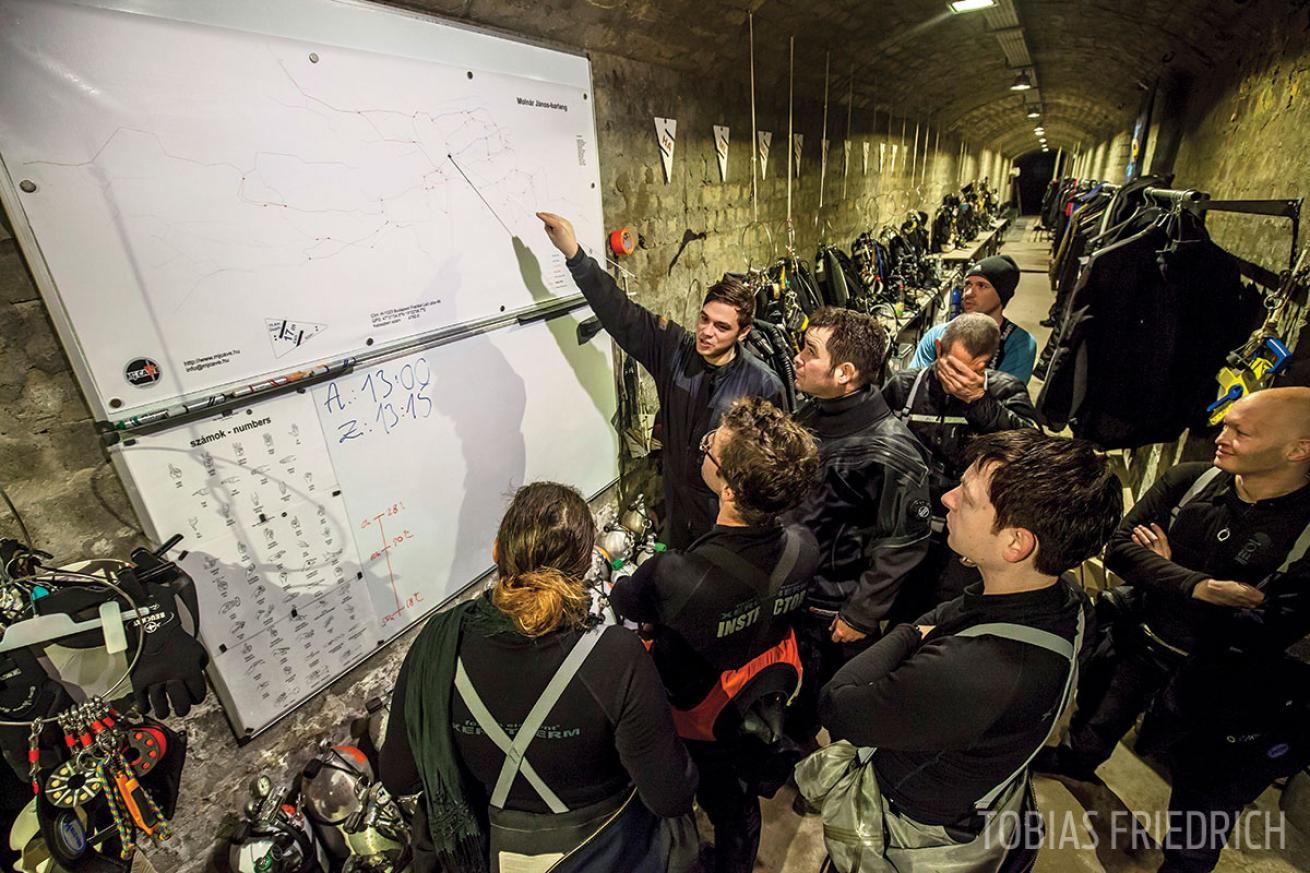
Tobias FriedrichCave diving instructor Zolton Bauer briefs divers about to enter a cave.
NEED TO KNOW
Getting There
Regular connections to this Central European metropolis are frequent from almost all major European airports. If you want to bring your own equipment, it’s worth renting a car at the airport.
Accommodations
The modern Regnum Residence hotel is located near the cave. The staff is friendly, and your stay includes a small breakfast. Cheaper is the Orion hotel in Budapest — it’s older and farther from the cave, but it’s in an ideal location for walking around the city.
Operator
All prices and rules for diving can be found on the Molnár János cave website.
Price
A dive to a maximum depth of 130 feet costs 70 euros, or about $75 USD. The price drops with multiple divers to about 50 euros, or $54 USD, for the same service. Deeper and longer dives cost between 70 and 170 euros, or about $75 to $185 USD.
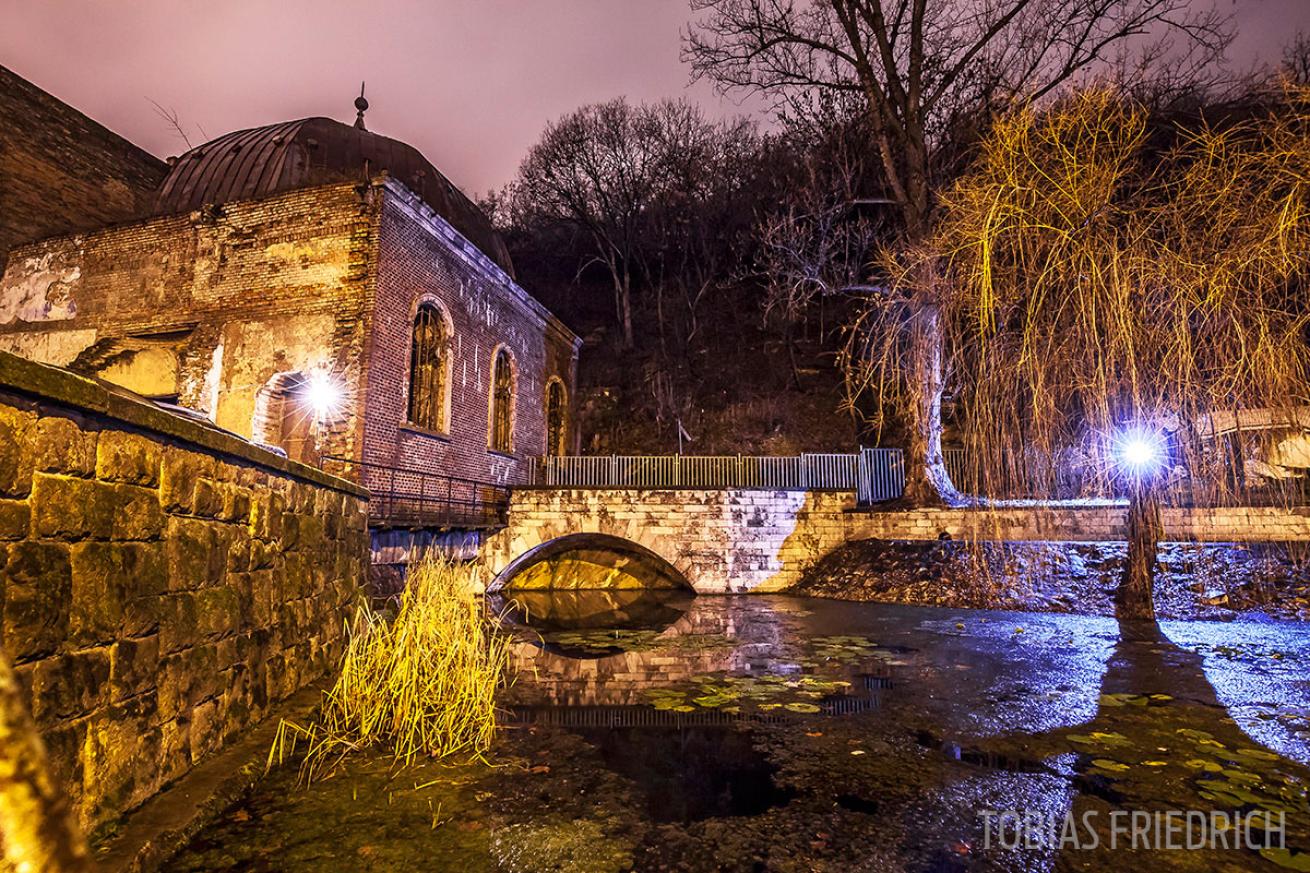
Tobias FriedrichThe old entrance to Molnár János.
What It Takes
Diving Molnár János cave requires a reservation — the cave is partially booked in advance for months. All documents must be up to date, including cave diving certification, a medical certificate, dive insurance covering cave dives, and a drysuit certification.
An introductory dive can be booked for 60 euros, about $65 USD, for divers without a cave-diving certification, using a wet or semidry suit. It’s highly recommended to read carefully and follow all rules.
5 Tips for Shooting in Budapest
1 ) Mount slave strobes on your buddies’ tanks for more light.
2 ) Place your buddy with a torch just behind somebody else to get a “sunbeam” effect.
3 ) Try to avoid any contact with walls or the cave floor to keep visibility good.
4 ) Shoot quickly; the longer you stay in one spot, the more sediment will be loosened by your bubbles.
5 ) Learn to use a rebreather. Get the Rig Tobias Friedrich used a Canon 1DX Mark II in a Seacam silver housing, a Canon 11-24mm wide-angle lens, Seacam Superdome for 11-24mm wide-angle and three Seacam Seaflash 150Ds. Diving Molnár János cave requires a reservation — the cave is partially booked in advance for months. All documents must be up to date, including cave diving certification, a medical certificate, dive insurance covering cave dives, and a drysuit certification.

